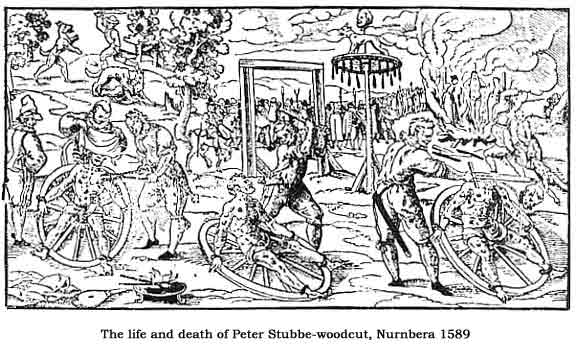 |
|
|
|
Web
Contents:
Portrait of a Werewolf and the Transformation Process Werewolves' Cases From Medieval French Chronicles Possible Explanations of Werewolf Phenomenon |
Origin of the Werewolf LegendDuring middle ages, especially from 15th to 17th century, Europe was under the dark shadow of ignorance and superstitions. Towns were underdeveloped and people lived near woods. The fear of wolves was like a nightmare. Their attacks were so frequent and atrocious in nature that people even feared to travel from one place to another. Every morning, countryside people would find half-eaten human limbs scattered on their fields. The first recorded Werewolf sighting took place around the countryside of German town Colongne and Bedburg in 1591. An age-old pamphlet describes those shivering moments vividly. Few people cornered a large wolf and set their dogs upon it. They started to pierce it with sharp sticks and spears. Surprisingly the ferocious wolf did not run away or tried to protect itself, rather it stood up and turned out to be a middle-aged man he was Peter Stubbe from the same village. Stubbe was put on a torture wheel where he confessed sixteen murders including two pregnant women and thirteen children. The history behind his downfall was rather bizarre. He had started to practice sorcery when he was only 12 and was so obsessed with it that even tried to make a pact with the Devil. Wearing a magic girdle he started to attack his enemies, real or imaginary. After several months, he would take the guise of a wolf and continued with his evil acts with more brutality. In the wolf form he used to tear up victims’ throats and suck warm blood from veins. Gradually his thirst for blood grew and he roamed around fields in search of prey.
The savagery of his crimes was beyond imagination. The trial record motioned few of them. Once two men and a woman were walking along a road that went through the forest Stubbe used to hide in. He called one of them into the forest. When the man did not return for a long time the second one followed his trail and also disappeared into the forest. When both the man didn't return for a long time the woman ran for her life. Later, two mangled male corpses were recovered from the forest, but the woman’s body never reappeared. It was believed that Stubbe had devoured it all. Young girls playing together or milking the cows in the fields were his frequent victims. He used to chase them like a hound, catch the slowest one, rape and kill her. Then he would drink hot blood and eat tender flesh from her body. However; the most gruesome sin he committed was upon his own son. He took him to a nearby forest, cracked the poor child’s skull open and ate brain from it. No punishment could match the magnitude of Stubbe’s crime. His flesh was pulled off with red-hot pincer, his arms and legs were broken and he was finally decapitated. His carcass was burned to ashes. The Magistrate of Bedburg built a grim monument remembering the ghastly incident. Workmen put the torture wheel atop a tall pole with Stubbe’s head above it structured with the likeliness of a wolf. Sixteen pieces of yard long wood cuts were hung from the rim of the wheel commemorating poor souls of the victims. The words of Stubbe’s trial and execution spread across the lands in no time. His brutality, atrocity and savagery were beyond human comprehension and was readily related with the behavior of a wolf. People started to believe that such individuals with the shadow of wolves were living among them. They named them Werewolves. |
Advertisement Free Version of the Site is Available on the Following Location:
|

